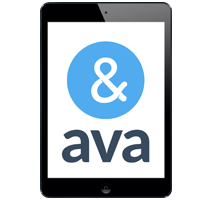 What is Hearing Assistive Technology? Many devices have been designed and developed for people with hearing loss. Such technology enhances sound, or substitutes sound with visual or tactile signals. Hearing AT can be helpful anywhere that effective communication is needed (e.g., at home, in schools, movies, theater, the workplace, hospitals, and on the telephone)
What is Hearing Assistive Technology? Many devices have been designed and developed for people with hearing loss. Such technology enhances sound, or substitutes sound with visual or tactile signals. Hearing AT can be helpful anywhere that effective communication is needed (e.g., at home, in schools, movies, theater, the workplace, hospitals, and on the telephone)
When do I need to use them? Listening needs vary with the situation and the level of hearing loss. Some challenging environments might be: restaurants, meetings, classes, houses of worship, social gatherings, public presentations, lectures, theaters, and home environments – TV, telephone, doorbell, smoke alarm, etc.
Who needs Hearing AT? Anyone who needs help with: face-to-face communication with others, enjoyment of electronic media (radio, stereo, television, movies, etc), telephone, and awareness of environmental sounds or similar situations.
Why aren’t hearing aids / cochlear implants enough? There can be environmental factors that further compromise your hearing: distance from the speaker, background noise, size and acoustics of the room.
Solutions for Persons with Hearing Needs:
(click to open the accordions below)
The links to solutions below are intended as examples only to give you an idea of the types of AT available. You may find more examples in the Resources section or by viewing the devices available for loan on the website of your state or territory AT program.
Resources for Hearing Needs
| Video/Webinar/Podcast Resources |
|---|
| AT3 Center AT Videos |
| HLAA Webinars |
| Video Series: Hearing Assistive Technology |
| Washington University: Hearing Assistive Technology |
| Video: Free to Low-Cost Assistive Technology Solutions |
| Video: Assistive Technology Solutions for Students who are Deaf or Hard of Hearing |
| Video: AT Assessment Made Easy |
| Video: Using the SETT Framework |
| Webinar: Hearing Note! You'll be asked to download an Adobe Connect application – it's safe and easy. |
| Personal FM vs. Sound Field FM (Classroom Audio Distribution System) |
Information on this page addresses Assistive Technology for people with hearing disabilities in...
EDUCATION | EMPLOYMENT | COMMUNITY LIVING
(click the titles above to jump to the content area)
EDUCATION
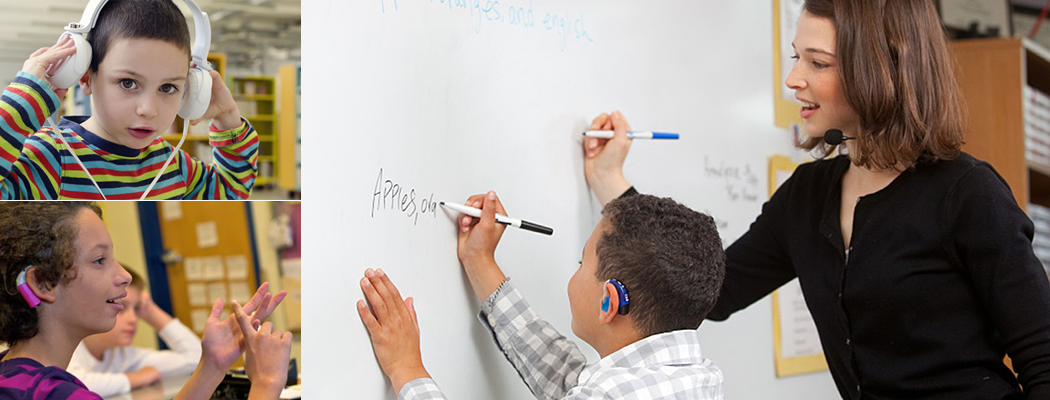
Talking Points for Hearing Assistive Technology in Education
The category of Education encompasses children - young and old - who are participating as a student whether at the pre-school, elementary, middle/junior/high school levels as well as institutions for higher education.
For children transitioning into the public school at age 3 - To ensure successful AT transitions for children turning 3 years old, it is important for any AT the child is currently using or may need to use in school, whether written into the child's Individualized Family Service Plan (IFSP) or not, be incorporated into the child's Individualized Education Program (IEP).
For students transitioning into the community or employment settings upon high school graduation - To ensure successful AT transitions for students aging out of school services, it is important for any AT the student is currently using or may need to pursue employment outcomes, whether written into the student's Individualized Education Program (IEP) or not, be incorporated into the student's Individualized Plan for Employment (IPE). IPEs are developed through collaboration with your state vocational rehabilitation agency using a Vocational Rehabilitation (VR) Counselor.
Situations where an individual might need hearing AT in employment include:
- Teacher lectures
- Small group activities
- Classmate comments/engagement during lunch or play
- Listening to computer tasks, audiobooks, or in-class movie
- Meeting with friends
- Sports coaching
- Music, games, TV
- Groups and club activities
- Safety - smoke alarms, tornado siren, or other emergency alarms
Commonly Asked Questions for a Student Who Has Hearing Aids or Cochlear Implants
Please listen to this section and/or download a transcript here: TXT format
Talking Points for Hearing Assistive Technology in Employment
The category of Employment encompasses those people of working-age who are currently employed or who are seeking employment. The following talking points may be applicable to individuals with disabilities as well as employers.
For students transitioning into the community or employment settings upon high school graduation - To ensure successful AT transitions for students aging out of school services, it is important for any AT the student is currently using or may need to pursue employment outcomes, whether written into the child's Individualized Education Program (IEP) or not, be incorporated into the student's Individualized Plan for Employment (IPE). IPEs are developed through collaboration with the state vocational rehabilitation agency using a Vocational Rehabilitation (VR) Counselor.
Situations where an individual might need AT for Hearing in Employment
- Interview process
- One to one meetings
- Group meetings
- Trainings in person and online
- Daily tasks
- Telecommunications – including customer service, conference calls, telephone on the road
- Networking
- Work lunches
- Social media
- Safety - smoke alarms, tornado siren, or other emergency alarms
- Preparing for work
- Waking up / alarm clock
- Transportation to and from work
- Employer-provided healthy living activities: gym, outdoor activities
Commonly Asked Questions in Employment for an Individual Who Has Hearing Loss
Q - I am about to lose my job because of my hearing loss, what do I do?
A - Consider Vocational Rehabilitation for help with keeping or getting a job. You can find contact information in the funding section of this page.
Q - Are there any laws that help me get accommodation or prevent discrimination in the workplace based on disability?
A - Yes. The Americans with Disabilities Act (ADA) and other federal laws that have provisions covering the workplace. The ADA, Title 1, requires employers to make reasonable accommodations to the known disability of a qualified applicant or employee, unless such accommodation would impose an undue hardship on the employer. Reasonable accommodations include a wide variety of actions – making worksites accessible, modifying existing equipment providing new devices, modifying work schedules, restructuring jobs, reassigning an employee to a vacant position, and providing readers or interpreters.
Q - What is a Hearing Loop?
A - A hearing loop is a wire that circles a room and is connected to a sound system. The loop transmits the sound electromagnetically. The electromagnetic signal is then picked up by the telecoil in the hearing aid or cochlear implant.
To use a hearing loop, you flip on the t-switch on the hearing aid or cochlear implant to activate the telecoil. Usually, no additional receiver or equipment is needed. Using a telecoil and hearing loop together is seamless, cost-effective, unobtrusive, and you don't have to seek additional equipment. Hearing loops are also called audio-induction loops, audio loops, or loops. If your hearing aid doesn't have a telecoil, you will need a headset plugged into a loop receiver to achieve the same effect.
Q - Excerpt from HLAA Employment Toolkit: “Looking for a job, landing a job, and keeping a job can be difficult under the best of circumstances.
A - Whether you are a graduating student seeking employment for the first time, looking to change jobs, returning to the workplace after an absence, or you are concerned about keeping a job, you might find employment issues more challenging if you have a hearing loss. There are ways to be successful in the workplace with a hearing loss. Landing a good job, fitting into the workplace, and successfully advocating for the kind of accommodations that will make you a productive and valued employee can all be accomplished. But you need the right tools, do your homework, find out what’s right for you and for your employer, and find ways to successfully advocate for yourself.”
A - As a person with a hearing loss in the workplace, it’s your responsibility to know what works best for you and communicate that to your employer. Your employer is required to provide adjustments or modifications to enable you to perform successfully.
- Pay attention to the situations where you do best and what causes the most difficulty – and why.
- Maximize your residual hearing, using an Assistive Listening System (ALS) or Assistive Listening Devices (ALDs) whenever possible.
- Anticipate problems and seek to minimize them. Do you spend more time on the phone or in meetings? Webinars? Conference calls? What can you do to make each of these situations less stressful?
Solutions for Employed Individuals with Hearing Impairments or Needs
(click to open the accordions below)
Talking Points for Assistive Technology for Hearing in Community Living
The category of Community Living encompasses infants and toddlers who are under the age of 3 and not yet in school, those people who were born with or have acquired an injury and are otherwise participating in community activities (not as students or employees) as well as those who are aging in the home. The following talking points are applicable to individuals with disabilities as well as family members and others providing support and care to these individuals with disabilities.
Situations where an individual might need assistive technology for Hearing
Socialization
- Lunches
- Social media
- Telecommunication
- Social Activities - bridge club, coffee shop, play dates
Community
- Doctor's office visits
- Hospital
- Shopping
- Transportation to, and from, events
- Volunteer activities
- Entertainment - Movies, plays or musicals
- Sports
- Library
- Religious activities - church, bible study
- Eating Out
Family/Home Environment
- Talking on the phone
- Paying bills
- TV/Radio
- Doing chores
- Games
- Computer tasks/games
- Safety - fire alarm, tornado, carbon monoxide
Commonly Asked Questions for a Person Who Has Hearing Loss - Impairment - Needs
Q - I have hearing aids – isn’t that enough?
A - Hearing Assistive Technology, or HAT as it is commonly referred to, is technology that can help in various listening situations.
Often, a hearing aid or an implant is not enough in certain situations. In such cases, there are technologies that are designed to help people with hearing loss. These are designed to enhance telephone communication, TV reception, ensure an effective smoke alarm, or listening in various kinds of public venues. Your hearing professional should evaluate your need for one or more of these devices and direct you to the appropriate vendor.

 Follow these basic communication tips for communicating with someone who has hearing loss:
Follow these basic communication tips for communicating with someone who has hearing loss: This student has recently been fitted with hearing aids, but needs additional assistance in multiple environments, including the classroom, art class, and gymnasium for physical education. Student is having a hard time staying focused in the general classroom, and not able to follow directions well in the gymnasium and art class, where room acoustics are very noisy with excessive reverberation.
This student has recently been fitted with hearing aids, but needs additional assistance in multiple environments, including the classroom, art class, and gymnasium for physical education. Student is having a hard time staying focused in the general classroom, and not able to follow directions well in the gymnasium and art class, where room acoustics are very noisy with excessive reverberation.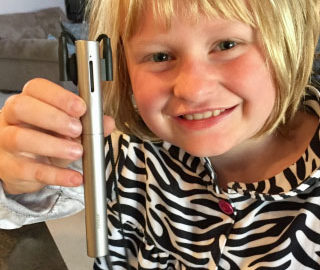 Possible Recommendations: In this case study, the student is very young, and the audiologist is involved on the recommendations. The needs are very specific because the AT needs to be able to go into multiple environments. The recommendation is an
Possible Recommendations: In this case study, the student is very young, and the audiologist is involved on the recommendations. The needs are very specific because the AT needs to be able to go into multiple environments. The recommendation is an .png)
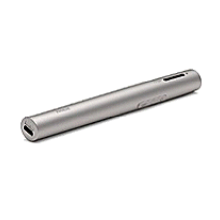
 This case study is based on a student who is in the classroom setting where some of the classroom learning is based on teacher lecture, while other is based on group work or group discussions. The student's participation is marginal, and the teacher would like to see the student benefit from more classroom participation. The student’s challenges are with being able to hear the teacher over the other classroom noise, and to hear the other students as they interact in group discussions. The student wears hearing aids, but still needs assistance with noise to sound ratio, and hearing discussions clearly.
This case study is based on a student who is in the classroom setting where some of the classroom learning is based on teacher lecture, while other is based on group work or group discussions. The student's participation is marginal, and the teacher would like to see the student benefit from more classroom participation. The student’s challenges are with being able to hear the teacher over the other classroom noise, and to hear the other students as they interact in group discussions. The student wears hearing aids, but still needs assistance with noise to sound ratio, and hearing discussions clearly.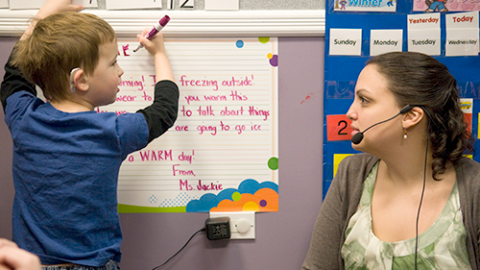 Goals and Outcomes: The student will show increased participation in classroom discussions by using the personal amplification system. Some suggested goals to track outcomes are to track the percentage of questions answered appropriately / on topic; tracking the increase in social interaction with peers during group work with verbal exchange; tracking student’s initiative to ask for the pass around mic or requesting peers repeat statements independently.
Goals and Outcomes: The student will show increased participation in classroom discussions by using the personal amplification system. Some suggested goals to track outcomes are to track the percentage of questions answered appropriately / on topic; tracking the increase in social interaction with peers during group work with verbal exchange; tracking student’s initiative to ask for the pass around mic or requesting peers repeat statements independently.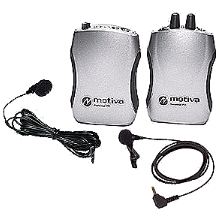
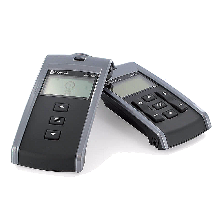
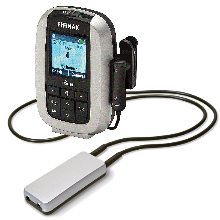
 Possible Recommendations: An AT solution would be a Sound Amplification Device that will accommodate his hearing aids to improve his hearing in group discussions, as well as on the computer or video. Ideally, it would be a unit where the transmitter and receiver are two separate units: the speaker wears a microphone/transmitter and there are also additional microphones in the classroom for peers to speak into. The student wears the receiver that captures the sound coming from the microphone and creates better noise to sound ratio. The most effective receiver would be an ear level receiver, such as a boot receiver that attaches to the hearing aid. If not, the receiver could be used with a neckloop, feeding directly into the hearing aid Telecoil. When a student wears hearing aids, they are always encouraged to consult their audiologist for their best recommendations.
Possible Recommendations: An AT solution would be a Sound Amplification Device that will accommodate his hearing aids to improve his hearing in group discussions, as well as on the computer or video. Ideally, it would be a unit where the transmitter and receiver are two separate units: the speaker wears a microphone/transmitter and there are also additional microphones in the classroom for peers to speak into. The student wears the receiver that captures the sound coming from the microphone and creates better noise to sound ratio. The most effective receiver would be an ear level receiver, such as a boot receiver that attaches to the hearing aid. If not, the receiver could be used with a neckloop, feeding directly into the hearing aid Telecoil. When a student wears hearing aids, they are always encouraged to consult their audiologist for their best recommendations.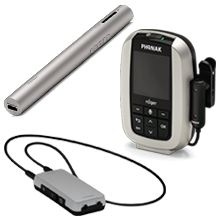




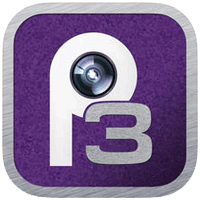
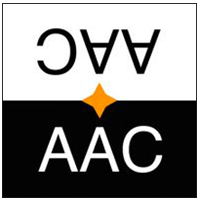
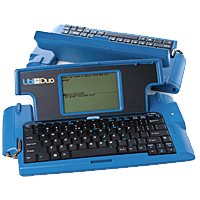
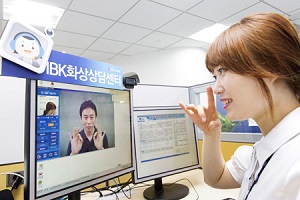
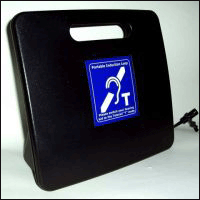


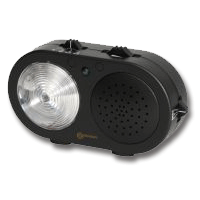

 While awaiting hearing aids, she needs amplification for therapy sessions.
While awaiting hearing aids, she needs amplification for therapy sessions.
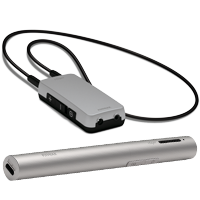
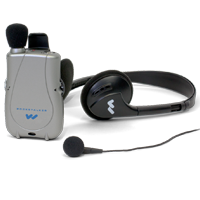
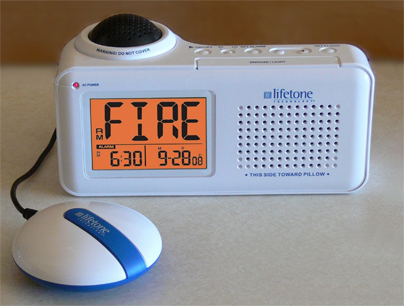 Possible Recommendations:
Possible Recommendations: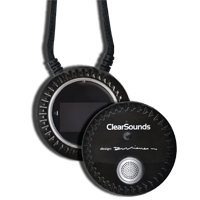

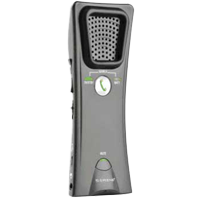
 Possible Recommendations:
Possible Recommendations: